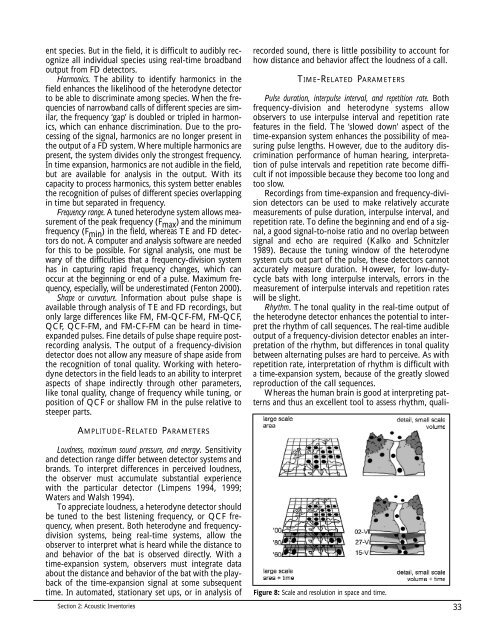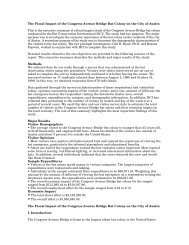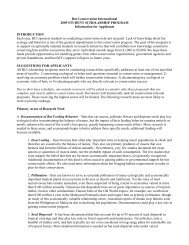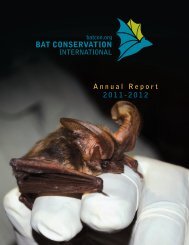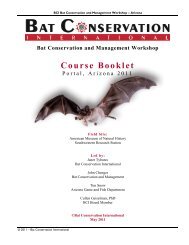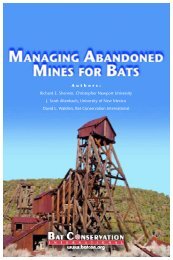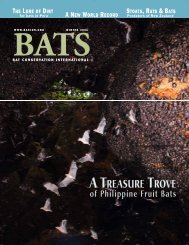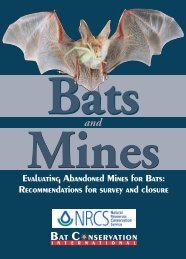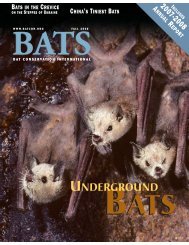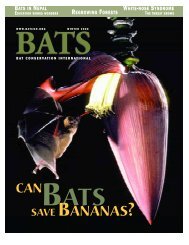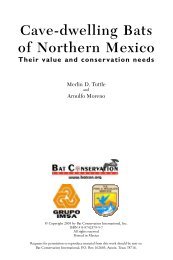Bat Echolocation Researc h - Bat Conservation International
Bat Echolocation Researc h - Bat Conservation International
Bat Echolocation Researc h - Bat Conservation International
Create successful ePaper yourself
Turn your PDF publications into a flip-book with our unique Google optimized e-Paper software.
ent species. But in the field, it is difficult to audibly recognize<br />
all individual species using real-time broadband<br />
output from FD detectors.<br />
Harmonics. The ability to identify harmonics in the<br />
field enhances the likelihood of the heterodyne detector<br />
to be able to discriminate among species. When the frequencies<br />
of narrowband calls of different species are similar,<br />
the frequency ‘gap’ is doubled or tripled in harmonics,<br />
which can enhance discrimination. Due to the processing<br />
of the signal, harmonics are no longer present in<br />
the output of a FD system. Where multiple harmonics are<br />
present, the system divides only the strongest frequency.<br />
In time expansion, harmonics are not audible in the field,<br />
but are available for analysis in the output. With its<br />
capacity to process harmonics, this system better enables<br />
the recognition of pulses of different species overlapping<br />
in time but separated in frequency.<br />
Frequency range. A tuned heterodyne system allows measurement<br />
of the peak frequency (F max ) and the minimum<br />
frequency (F min ) in the field, whereas TE and FD detectors<br />
do not. A computer and analysis software are needed<br />
for this to be possible. For signal analysis, one must be<br />
wary of the difficulties that a frequency-division system<br />
has in capturing rapid frequency changes, which can<br />
occur at the beginning or end of a pulse. Maximum frequency,<br />
especially, will be underestimated (Fenton 2000).<br />
Shape or curvature. Information about pulse shape is<br />
available through analysis of TE and FD recordings, but<br />
only large differences like FM, FM-QCF-FM, FM-QCF,<br />
QCF, QCF-FM, and FM-CF-FM can be heard in timeexpanded<br />
pulses. Fine details of pulse shape require postrecording<br />
analysis. The output of a frequency-division<br />
detector does not allow any measure of shape aside from<br />
the recognition of tonal quality. Working with heterodyne<br />
detectors in the field leads to an ability to interpret<br />
aspects of shape indirectly through other parameters,<br />
like tonal quality, change of frequency while tuning, or<br />
position of QCF or shallow FM in the pulse relative to<br />
steeper parts.<br />
recorded sound, there is little possibility to account for<br />
how distance and behavior affect the loudness of a call.<br />
TIME-RELATED PARAMETERS<br />
Pulse duration, interpulse interval, and repetition rate. Both<br />
frequency-division and heterodyne systems allow<br />
observers to use interpulse interval and repetition rate<br />
features in the field. The ‘slowed down’ aspect of the<br />
time-expansion system enhances the possibility of measuring<br />
pulse lengths. However, due to the auditory discrimination<br />
performance of human hearing, interpretation<br />
of pulse intervals and repetition rate become difficult<br />
if not impossible because they become too long and<br />
too slow.<br />
Recordings from time-expansion and frequency-division<br />
detectors can be used to make relatively accurate<br />
measurements of pulse duration, interpulse interval, and<br />
repetition rate. To define the beginning and end of a signal,<br />
a good signal-to-noise ratio and no overlap between<br />
signal and echo are required (Kalko and Schnitzler<br />
1989). Because the tuning window of the heterodyne<br />
system cuts out part of the pulse, these detectors cannot<br />
accurately measure duration. However, for low-dutycycle<br />
bats with long interpulse intervals, errors in the<br />
measurement of interpulse intervals and repetition rates<br />
will be slight.<br />
Rhythm. The tonal quality in the real-time output of<br />
the heterodyne detector enhances the potential to interpret<br />
the rhythm of call sequences. The real-time audible<br />
output of a frequency-division detector enables an interpretation<br />
of the rhythm, but differences in tonal quality<br />
between alternating pulses are hard to perceive. As with<br />
repetition rate, interpretation of rhythm is difficult with<br />
a time-expansion system, because of the greatly slowed<br />
reproduction of the call sequences.<br />
Whereas the human brain is good at interpreting patterns<br />
and thus an excellent tool to assess rhythm, quali-<br />
AMPLITUDE-RELATED PARAMETERS<br />
Loudness, maximum sound pressure, and energy. Sensitivity<br />
and detection range differ between detector systems and<br />
brands. To interpret differences in perceived loudness,<br />
the observer must accumulate substantial experience<br />
with the particular detector (Limpens 1994, 1999;<br />
Waters and Walsh 1994).<br />
To appreciate loudness, a heterodyne detector should<br />
be tuned to the best listening frequency, or QCF frequency,<br />
when present. Both heterodyne and frequencydivision<br />
systems, being real-time systems, allow the<br />
observer to interpret what is heard while the distance to<br />
and behavior of the bat is observed directly. With a<br />
time-expansion system, observers must integrate data<br />
about the distance and behavior of the bat with the playback<br />
of the time-expansion signal at some subsequent<br />
time. In automated, stationary set ups, or in analysis of<br />
Section 2: Acoustic Inventories<br />
Figure 8: Scale and resolution in space and time.<br />
33


